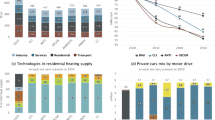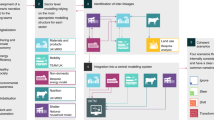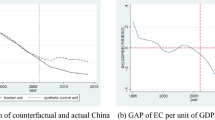Abstract
Energy use is not only crucial for economic development, but is also the main driver of greenhouse-gas emissions. Developing countries can reduce emissions and thrive only if economic growth is disentangled from energy-related emissions. Although possible in theory, the required energy-system transformation would impose considerable costs on developing nations. Developed countries could bear those costs fully, but policy design should avoid a possible 'climate rent curse', that is, a negative impact of financial inflows on recipients' economies. Mitigation measures could meet further resistance because of adverse distributional impacts as well as political economy reasons. Hence, drastically re-orienting development paths towards low-carbon growth in developing countries is not very realistic. Efforts should rather focus on 'feasible mitigation actions' such as fossil-fuel subsidy reform, decentralized modern energy and fuel switching in the power sector.
This is a preview of subscription content, access via your institution
Access options
Subscribe to this journal
Receive 12 print issues and online access
$209.00 per year
only $17.42 per issue
Buy this article
- Purchase on Springer Link
- Instant access to full article PDF
Prices may be subject to local taxes which are calculated during checkout




Similar content being viewed by others
References
Olivier, J. G. J., Janssens-Maenhout, G. & Peters, J. A. H. W. Trends in Global CO2 Emissions: 2013 Report (PBL Netherlands Environmental Assessment Agency, 2013); www.pbl.nl/en
International Energy Agency World Energy Outlook 2011 (IEA, 2011).
Luderer, G. et al. The economics of decarbonizing the energy system — results and insights from the RECIPE model intercomparison. Climatic Change 14, 9–37 (2011).
Organisation for Economic Co-operation and Development Towards Green Growth (OECD, 2011); www.oecd.org/dataoecd/37/34/48224539.pdf
United Nations Environment Programme Towards a Green Economy: Pathways to Sustainable Development and Poverty Eradication (OECD, 2011); www.unep.org/greeneconomy/greeneconomyreport/tabid/29846/default.aspx
World Bank Inclusive Green Growth: The Pathway to Sustainable Development (World Bank, 2012); https://openknowledge.worldbank.org/bitstream/handle/10986/6058/9780821395516.pdf?sequence=1
Stern, N. A Blueprint for a Safer Planet: How to Manage Climate Change and Create a New Era of Progress and Prosperity (Bodley Head, 2009).
World Bank World Development Report (World Bank, 2010).
Grübler, A. Transitions in Energy Use (International Institute for Applied Systems Analysis, 2004).
Schäfer, A. Structural change in energy use. Energ. Policy 33, 429–437 (2005).
Costa, L., Rybski, D. & Kropp, J. P. A human development framework for CO2 reductions. PLoS ONE 6, e29262 (2011).
Steinberger, J. K. & Roberts, J. T. From constraint to sufficiency: the decoupling of energy and carbon from human needs, 1975–2005. Ecol. Econ. 70, 425–433 (2010).
Steckel, J. C., Brecha, R. J., Jakob, M., Strefler, J. & Luderer, G. Development without energy? Assessing future scenarios of energy consumption in developing countries. Ecol. Econ. 90, 53–67 (2013).
Pereira, M. G., Sena, J. A., Freitas, M. A. V. & da Silva, N. F. Evaluation of the impact of access to electricity: a comparative analysis of South Africa, China, India and Brazil. Renew. Sust. Energ. Rev. 15, 1427–1441 (2011).
Minx, J. C. et al. A 'carbonizing dragon': China's fast growing CO2 emissions revisited. Environ. Sci. Technol. 45, 9144–9153 (2011).
Steckel, J. C., Jakob, M., Marschinski, R. & Luderer, G. From carbonization to decarbonization? Past trends and future scenarios for China's CO2 emissions. Energ. Policy 39, 3443–3455 (2011).
Davis, S. J. & Caldeira, K. Consumption-based accounting of CO2 emissions. Proc. Natl Acad. Sci. USA 107, 5687–5692 (2010).
Peters, G. P., Minx, J. C., Weber, C. L. & Edenhofer, O. Growth in emission transfers via international trade from 1990 to 2008. Proc. Natl Acad. Sci. USA 108, 8903–8908 (2011).
Jakob, M. & Marschinski, R. Interpreting trade-related CO2 emission transfers. Nature Clim. Change 3, 19–23 (2012).
Jakob, M., Haller, M. & Marschinski, R. Will history repeat itself? Economic convergence and convergence in energy use patterns. Energ. Econ. 34, 95–104 (2012).
Jakob, M. & Steckel, J. C. How climate change mitigation could harm development in poor countries. WIREs Clim. Change 5, 161–168 (2014).
Collier, P. & Venables, A. J. Greening Africa? Technologies, endowments and the latecomer effect. Energ. Econ. 34, S75–S84 (2012).
Grunewald, N., Harteisen, M., Lay, J., Minx, J. & Renner, S. The Carbon Footprint of Indian Households (International Association for Research in Income and Wealth, 2012); www.iariw.org/papers/2012/GrunewaldPaper.pdf
Irfany, I. Affluence and Emission Trade-offs: Evidence from Indonesian Household Carbon Footprint (Courant Research Centre: Poverty, Equity and Growth - Discussion Papers, No. 161, Univ. of Göttingen, 2014); https://www.econstor.eu/dspace/bitstream/10419/100103/1/791342972.pdf
Seriño, M. N. V. Do Philippine Households Lead a Carbon Intensive Lifestyle? (Courant Research Centre: Poverty, Equity and Growth-Discussion Papers No. 158; 2014); http://www.econstor.eu/handle/10419/100100
Grunewald, N., Klasen, S., Martínez-Zarzoso, I. & Muris, C. Income Inequality and Carbon Emissions (Courant Research Centre PEG, 2011); http://ideas.repec.org/p/got/gotcrc/092.html
Jakob, M., Steckel, J. C., Flachsland, C. & Baumstark, L. Climate finance for developing country mitigation: Blessing or curse? Clim. Dev. http://dx.doi.org/10.1080/17565529.2014.934768
Olbrisch, S., Haites, E., Savage, M., Dadhich, P. & Shrivastava, M. K. Estimates of incremental investment for and cost of mitigation measures in developing countries. Clim. Policy 11, 970–986 (2011).
Ekholm, T., Krey, V., Pachauri, S. & Riahi, K. Determinants of household energy consumption in India. Energ. Policy 38, 5696–5707 (2010).
IPCC Climate Change 2007 Mitigation of Climate Change (eds Metz, B. et al.) (Cambridge Univ. Press, 2007).
Klein, D. et al. The value of bioenergy in low stabilization scenarios: an assessment using REMIND-MAgPIE. Climatic Change 123, 705–718 (2014).
Pfeiffer, B. & Mulder, P. Explaining the diffusion of renewable energy technology in developing countries. Energ. Econ. 40, 285–296 (2013).
IPCC Special Report on Renewable Energy Sources and Climate Change Mitigation (eds Edenhofer, O. et al.) (Cambridge Univ. Press, 2011).
Edenhofer, O., Seyboth, K., Creutzig, F. & Schlömer, S. On the sustainability of renewable energy sources. Annu. Rev. Environ. Resourc. 38, 169–200 (2013).
Joskow, P. L. Comparing the costs of intermittent and dispatchable electricity generating technologies. Am. Econ. Rev. 101, 238–41 (2011).
Ueckerdt, F., Hirth, L., Luderer, G. & Edenhofer, O. System LCOE: What are the costs of variable renewables? Energy 63, 61–75 (2013);
Staub-Kaminski, I., Zimmer, A., Jakob, M. & Marschinski, R. Climate policy in practice: a typology of obstacles and implications for integrated assessment modeling. Clim. Change Econ. 5, 1440004 (2014).
Casillas, C. E. & Kammen, D. M. The energy–poverty–climate nexus. Science 330, 1181–1182 (2010).
Barnes, D. F. & Floor, W. M. Rural energy in developing countries: a challenge for economic development. Annu. Rev. Energ. Environ. 21, 497–530 (1996).
Lay, J., Ondraczek, J. & Stoever, J. Renewables in the energy transition: evidence on solar home systems and lighting fuel choice in Kenya. Energ. Econ. 40, 350–359 (2013).
Demailly, D. & Verley, P. The Aspirations of the Green Industrial Revolution: A Historical Perspective (IDDRI, 2013); www.iddri.org/Publications/Les-espoirs-de-la-revolution-industrielle-verte-une-perspective-historique
Jakob, M., Luderer, G., Steckel, J., Tavoni, M. & Monjon, S. Time to act now? Assessing the costs of delaying climate measures and benefits of early action. Climatic Change 114, 79–99 (2011).
Kalkuhl, M., Edenhofer, O. & Lessmann, K. Learning or lock-in: optimal technology policies to support mitigation. Resourc. Energ. Econ. 34, 1–23 (2012).
Mattoo, A. & Subramanian, A. Equity in climate change: an analytical review. World Dev. 40, 1083–1097 (2012).
German Advisory Council on Global Change Solving the Climate Dilemma: The Budget Approach (WBGU, 2009).
Nordhaus, W. To tax or not to tax: alternative approaches to slowing global warming. Rev. Environ. Econ. Policy 1, 26–42 (2007).
Sachs, J. D. & Warner, A. M. Natural Resource Abundance and Economic Growth (National Bureau of Economic Research, 1995); http://ideas.repec.org/p/nbr/nberwo/5398.html
van der Ploeg, F. Natural resources: Curse or blessing? J. Econ. Lit. 49, 366–420 (2011).
Kornek, U., Steckel, J. C. & Edenhofer, O. The Climate Rent Curse: New Challenges for Burden Sharing (Working Paper, Potsdam Institute for Climate Impact Research, 2013); https://www.pik-potsdam.de/members/steckel/publications/kornek-etal-wp.pdf
Kaufmann, D., Kraay, A. & Mastruzzi, M. The Worldwide Governance Indicators: Methodology and Analytical Issues (World Bank, 2010); http://ideas.repec.org/p/wbk/wbrwps/5430.html
Worldwide Governance Indicators Worldwide Governance Indicators (WGI, 2012); govindicators.org
Weikard, H-P. Cartel stability under optimal sharing rules. Manch. Sch. 77, 575–593 (2009).
Bowen, A., Campiglio, E. & Tavoni, M. A Macroeconomic Perspective on Climate Change Mitigation: Meeting the Financing Challenge (Grantham Research Institute on Climate Change and the Environment, 2013); http://ideas.repec.org/p/lsg/lsgwps/wp122.html
Klasen, S. The efficiency of equity. Rev. Polit. Econ. 20, 257–274 (2008).
Rodrik, D. Where did all the growth go? External shocks, social conflict, and growth collapses. J. Econ. Growth 4, 385–412 (1999).
Robinson, J. A. & Acemoglu, D. Political losers as a barrier to economic development. Am. Econ. Rev. 90, 126–130 (2000).
Townshend, T. et al. How national legislation can help to solve climate change. Nature Clim. Change 3, 430–432 (2013).
Ostrom, E. Polycentric systems for coping with collective action and global environmental change. Glob. Environ. Change 20, 550–557 (2010).
Dubash, N. K. The politics of climate change in India: narratives of equity and cobenefits. WIREs Clim. Change 4, 191–201 (2013).
Zimmer, A., Jakob, M. & Steckel, J. What Motivates Vietnam to Strive for a Low Carbon Economy? An Explorative Case Study on the Drivers of Climate Policy in a Developing Country (International Conference on Public Policy, 2013); www.icpublicpolicy.org/IMG/pdf/panel_46_s2_zimmer.pdf
Kahn Ribeiro, S. et al. in Global Energy Assessment — Toward a Sustainable Future (eds Johansson, T. B. et al.) 575–648 (Cambridge Univ. Press, 2012); www.globalenergyassessment.org
Parry, I. W. H. & Small, K. A. Does Britain or the United States have the right gasoline tax? Am. Econ. Rev. 95, 1276–1289 (2005).
Creutzig, F. & He, D. Climate change mitigation and co-benefits of feasible transport demand policies in Beijing. Transport. Res. D 14, 120–131 (2009).
Organisation for Economic Co-operation and Development & International Energy Agency OECD-IEA Fossil Fuel Subsidies and Other Support (OECD, 2014); www.oecd.org/site/tadffss
Davis, L. W. The Economic Cost of Global Fuel Subsidies (National Bureau of Economic Research, 2013); http://ideas.repec.org/p/nbr/nberwo/19736.html.
Sterner, T. Fuel Taxes and the Poor: The Distributional Effects of Gasoline Taxation and Their Implications for Climate Policy (Johns Hopkins Univ. Press, 2011).
Lay, J., Renner, S. & Schleicher, M. Distributional Implications of Energy Subsidy Reform in Indonesia (GIGA, 2014).
Brons, M., Nijkamp, P., Pels, E. & Rietveld, P. A meta-analysis of the price elasticity of gasoline demand. A SUR approach. Energ. Econ. 30, 2105–2122 (2008).
Strand, J. Political Economy Aspects of Fuel Subsidies: A Conceptual Framework (World Bank, 2013); http://ideas.repec.org/p/wbk/wbrwps/6392.html
Clements, B., Coady, D., Fabrizio, S., Gupta, S. & Shang, B. Energy subsidies: How large are they and how can they be reformed? Econ. Energ. Environ. Policy 3, http://dx.doi.org/10.5547/2160-5890.3.1.bcle (2014).
Rao, N. D. Kerosene subsidies in India: when energy policy fails as social policy. Energ. Sust. Dev. 16, 35–43 (2012).
International Monetary Fund Energy Subsidy Reform: Lessons and Implications (IMF, 2013); www.imf.org/external/np/pp/eng/2013/012813.pdf
World Bank Implementing Energy Subsidy Reforms: Evidence from Developing Countries (World Bank, 2012); http://dx.doi.org/10.1596/978-0-8213-9561-5
Pachauri, S. et al. Pathways to achieve universal household access to modern energy by 2030. Environ. Res. Lett. 8, 024015 (2013).
Detchon, R. & Van Leeuwen, R. Bring sustainable energy to the developing world. Nature 508, 309–311 (2014).
Modi, V., McDade, S., Lallement, D. & Saghir, J. Energy Services for the Millennium Development Goals (Energy Sector Management Assistance Programme, United Nations Development Programme, 2005).
Rogelj, J., McCollum, D. L. & Riahi, K. The UN's 'Sustainable Energy for All' initiative is compatible with a warming limit of 2 °C. Nature Clim. Change 3, 545–551 (2013).
Schnitzer, D. et al. Microgrids for Rural Electrification: A Critical Review of Best Practices Based on Seven Case Studies (United Nations Foundation, 2014).
Brauer, M. et al. Exposure assessment for estimation of the global burden of disease attributable to outdoor air pollution. Environ. Sci. Technol. 46, 652–660 (2011).
Sheehan, P., Cheng, E., English, A. & Sun, F. China's response to the air pollution shock. Nature Clim. Change 4, 306–309 (2014).
Nemet, G. F., Holloway, T. & Meier, P. Implications of incorporating air-quality co-benefits into climate change policymaking. Environ. Res. Lett. 5, 014007 (2010).
West, J. J. et al. Co-benefits of mitigating global greenhouse gas emissions for future air quality and human health. Nature Clim. Change 3, 885–889 (2013).
McCollum, D. L., Krey, V. & Riahi, K. An integrated approach to energy sustainability. Nature Clim. Change 1, 428–429 (2011).
Tubiello, F. N. et al. The FAOSTAT 19 database of greenhouse gas emissions from agriculture. Environ. Res. Lett. 8, 035019 (2013).
Kissinger, G., Herold, M. & de Sy, V. Drivers of Deforestation and Forest Degradation: A Synthesis Report for REDD+ Policymakers (Lexeme Consulting, 2012).
United Nations Environment Programme The Emissions Gap Report 2013 (UNEP, 2013); www.unep.org/pdf/UNEPEmissionsGapReport2013.pdf
Smith, P. et al. Greenhouse gas mitigation in agriculture. Phil. Trans. R. Soc. B 363, 789–813 (2008).
International Rice Research Institute Smart Water Technique for Rice (IRRI, 2013).
Chen, Y. & Whalley, A. Green infrastructure: the effects of urban rail transit on air quality. AEJ Econ. Policy 4, 58–97 (2012).
Creutzig, F., Baiocchi, G., Bierkandt, R., Pichler, P-P. & Seto, K. A global typology of urban energy use and potentials for an urbanization mitigation wedge. Urban Climate (in the press).
Baghdadi, L., Martinez-Zarzoso, I. & Zitouna, H. Are RTA agreements with environmental provisions reducing emissions? J. Int. Econ. 90, 378–390 (2013).
Prakash, A. & Potoski, M. Racing to the bottom? Trade, environmental governance, and ISO 14001. Am. J. Polit. Sci. 50, 350–364 (2006).
Freund, C. & Ornelas, E. Regional trade agreements. Annu. Rev. Econ. 2, 139–166 (2010).
Jakob, M., Steckel, J. C. & Edenhofer, O. Consumption- versus production-based emission policies. Annu. Rev. Resourc. Econ. http://dx.doi.org/10.1146/annurev-resource-100913-012342 (2014).
Urpelainen, J. A model of dynamic climate governance: dream big, win small. Int. Environ. Agreem. 13, 107–125 (2013).
United Nations Framework Convention on Climate Change Decision 2/CP.15 (UNFCCC, 2009); https://unfccc.int/meetings/copenhagen_dec_2009/items/5262.php
Carbon Dioxide Information Analysis Centre Fossil-Fuel CO2 Emissions by Nation (CDIAC, 2013); http://cdiac.ornl.gov
Maddison, A. Statistics on World Population, GDP and Per Capita GDP, 1–2008 AD (Univ. of Groningen, 2010); http://www.ggdc.net/maddison/oriindex.htm
Krey, V. & Clarke, L. Role of renewable energy in climate mitigation: a synthesis of recent scenarios. Clim. Policy 11, 1131–1158 (2011).
World Bank World Development Indicators (World Bank, 2014); http://data.worldbank.org/data-catalog/world-development-indicators
Acknowledgements
The authors thank F. Creutzig, S. Hallegatte, N. Rao, E. Somanathan and T. Venables for useful comments and suggestions. Funding from the German Federal Ministry of Education and Research (funding code 01UV1008A, EntDekEn) is gratefully acknowledged.
Author information
Authors and Affiliations
Contributions
M.J., J.C.S., S.K., J.L. and O.E. were involved in conceptualizing the paper. J.C.S. and M.J. analysed data, conceptualized and produced graphs. N.G. and I.M-Z. performed analyses on inequality issues and S.R. provided household-level analyses. M.J., J.C.S., J.L., S.K., I.M-Z. and S.R. wrote the paper.
Corresponding authors
Ethics declarations
Competing interests
The authors declare no competing financial interests.
Supplementary information
Supplementary Information
Supplementary Information (PDF 449 kb)
Rights and permissions
About this article
Cite this article
Jakob, M., Steckel, J., Klasen, S. et al. Feasible mitigation actions in developing countries. Nature Clim Change 4, 961–968 (2014). https://doi.org/10.1038/nclimate2370
Received:
Accepted:
Published:
Issue Date:
DOI: https://doi.org/10.1038/nclimate2370
This article is cited by
-
Towards synergy: network facility development, whole process carbon reduction and pollution reduction, and regional disparities
Environmental Science and Pollution Research (2024)
-
The effect of income inequality and economic growth on carbon dioxide emission
Environmental Science and Pollution Research (2023)
-
Catalysts for sustainable energy transitions: the interplay between financial development, green technological innovations, and environmental taxes in European nations
Environment, Development and Sustainability (2023)
-
Co-benefits of CO2 emission reduction from China’s clean air actions between 2013-2020
Nature Communications (2022)
-
Assessment of wind energy technology adoption, application and utilization: a critical review
International Journal of Environmental Science and Technology (2022)



